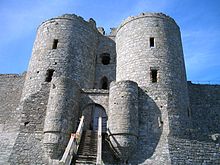Harlech Castle
[2] Over the next few centuries, the castle played an important part in several wars, withstanding the siege of Madog ap Llywelyn between 1294 and 1295, but falling to Prince Owain Glyndŵr in 1404.
Following the outbreak of the English Civil War in 1642, the castle was held by forces loyal to Charles I, holding out until 1647 when it became the last fortification to surrender to the Parliamentary armies.
In the 21st century the ruined castle is managed by Cadw, the Welsh Government's historic environment service, as a tourist attraction.
[3] The fortification is built of local stone and concentric in design, featuring a massive gatehouse that probably once provided high-status accommodation for the castle constable and visiting dignitaries.
[6] English forces advanced down the Conwy valley and through Dolwyddelan and Castell y Bere, onto Harlech, which Sir Otton de Grandson took with 560 infantry in May.
[4] Money to pay for the initial phase arrived in mid-May and carpenters and 35 stonemasons were dispatched in June and July to commence work.
[11] In 1286, at the height of the construction, the workforce comprised 546 general labourers, 115 quarriers, 30 blacksmiths, 22 carpenters and 227 stonemasons, and the project was costing nearly £240 a month.
[16] Further work was undertaken between 1323 and 1324, following the Despenser War; Edward II was threatened in the region by the Mortimer Marcher Lord family, and ordered his sheriff, Sir Gruffudd Llwyd, to extend the defences leading up to the gatehouse with additional towers.
In 1460, following the Battle of Northampton, Queen Margaret of Anjou fled to the castle and between 1461 and 1468 it was held by her Lancastrian supporters, under the command of Dafydd ap Ieuan, against the Yorkist Edward IV.
[23] Thanks to its natural defences and the supply route by sea, Harlech held out and as other fortresses fell, eventually became the last major stronghold still under Lancastrian control.
[24] Tudor's arrival caused Edward IV to order William Herbert to mobilise an army, possibly up to 10,000 strong, to finally seize the castle.
[32] In 1914 it was transferred from the Merioneth Crown Estate to the control of the Office of Works, who commenced a major restoration project after the end of World War I.
[36] Harlech is built from local grey-green sandstone, with large, regular blocks used for the towers and irregular material, possibly taken from the ditch, used for the walls.
[46] These include semi-circular door arches, window styles, corbelled towers and positioning of putlog holes, and are usually ascribed to the influence of the Savoy architect Master James.
[48] The similarity in architectural details may, therefore, be the result of the wider role played by Savoy craftsmen and engineers on the Harlech project.





